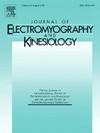Hamstrings corticomotor and neuromechanical function in individuals with anterior cruciate ligament reconstruction
IF 2.3
4区 医学
Q3 NEUROSCIENCES
引用次数: 0
Abstract
Hamstrings neuromuscular alterations are common after anterior cruciate ligament (ACL) reconstruction; however, their neural origins remain unclear. While quadriceps corticospinal function after ACL reconstruction (ACLR) is well studied, similar data for hamstrings are lacking. We aimed to assess hamstrings corticomotor and neuromechanical function and their associations in individuals with ACLR. Twenty-three adults with primary, unilateral ACLR via hamstrings tendon autograft were assessed (time from surgery = 46.9 ± 26.3). Corticomotor function was quantified via active motor threshold (AMT), motor evoked potential (MEP), short-interval intracortical inhibition, intracortical facilitation (ICF), and cortical silent period (CSP) in semitendinosus. Neuromechanical function was quantified via maximal voluntary isometric contraction (MVIC) torque, early and late-phase rate of torque development (RTD100, RTD200), and semitendinosus electromyographic amplitude. Paired-samples t-tests or Wilcoxon signed-rank tests compared outcomes between limbs. Associations between involved limb outcomes were analyzed using correlation coefficients. Involved limbs exhibited shorter CSP (p = 0.005), lower MVIC torque (p = 0.002), and lower RTD200 (p = 0.002) than uninvolved limbs. Lower AMT (r = 0.462, p = 0.026) and ICF (r = 0.510, p = 0.013) associated with lower RTD200, and lower MEP associated with lower MVIC torque (r = 0.448, p = 0.032). Hamstrings neural adaptation following ACLR, characterized by lower corticospinal inhibition (semitendinosus) and torque deficits, highlights the need for rehabilitation approaches targeting both neural and peripheral impairments.
前交叉韧带重建患者的腘绳肌皮质运动和神经力学功能
前交叉韧带(ACL)重建后腘绳肌神经肌肉改变是常见的;然而,它们的神经起源仍不清楚。虽然对前交叉韧带重建(ACLR)后的股四头肌皮质脊髓功能进行了很好的研究,但对腘绳肌缺乏类似的研究数据。我们的目的是评估ACLR患者的腘绳肌皮质运动和神经机械功能及其相关性。本研究评估了23例通过自体腘绳肌腱移植的原发性单侧ACLR成人患者(手术时间= 46.9±26.3)。通过半腱鼠的活动运动阈值(AMT)、运动诱发电位(MEP)、短间期皮质内抑制、皮质内促进(ICF)和皮质沉默期(CSP)对皮质运动功能进行量化。神经力学功能通过最大自主等距收缩(MVIC)扭矩、早期和晚期扭矩发展率(RTD100、RTD200)和半腱肌肌电振幅来量化。配对样本t检验或Wilcoxon符号秩检验比较四肢之间的结果。使用相关系数分析受累肢体预后之间的关联。受累肢体的CSP较短(p = 0.005), MVIC扭矩较低(p = 0.002), RTD200较低(p = 0.002)。较低的AMT (r = 0.462, p = 0.026)和ICF (r = 0.510, p = 0.013)与较低的RTD200相关,较低的MEP与较低的MVIC扭矩相关(r = 0.448, p = 0.032)。ACLR后腘绳肌神经适应,以下皮质脊髓抑制(半腱肌)和扭矩缺陷为特征,强调了针对神经和外周损伤的康复方法的必要性。
本文章由计算机程序翻译,如有差异,请以英文原文为准。
求助全文
约1分钟内获得全文
求助全文
来源期刊
CiteScore
4.70
自引率
8.00%
发文量
70
审稿时长
74 days
期刊介绍:
Journal of Electromyography & Kinesiology is the primary source for outstanding original articles on the study of human movement from muscle contraction via its motor units and sensory system to integrated motion through mechanical and electrical detection techniques.
As the official publication of the International Society of Electrophysiology and Kinesiology, the journal is dedicated to publishing the best work in all areas of electromyography and kinesiology, including: control of movement, muscle fatigue, muscle and nerve properties, joint biomechanics and electrical stimulation. Applications in rehabilitation, sports & exercise, motion analysis, ergonomics, alternative & complimentary medicine, measures of human performance and technical articles on electromyographic signal processing are welcome.

 求助内容:
求助内容: 应助结果提醒方式:
应助结果提醒方式:


